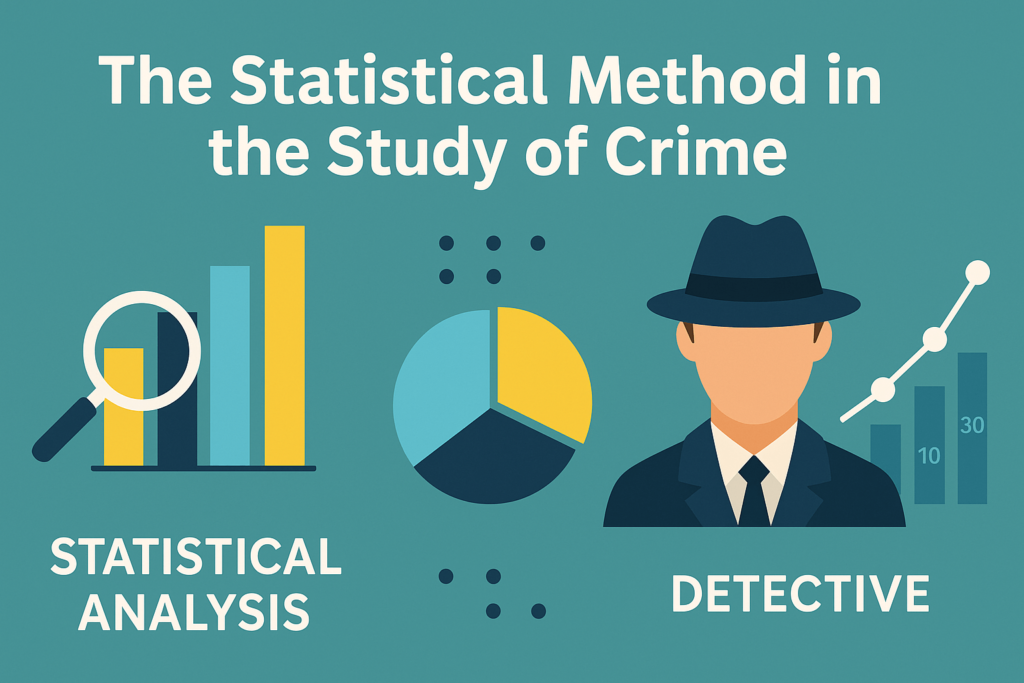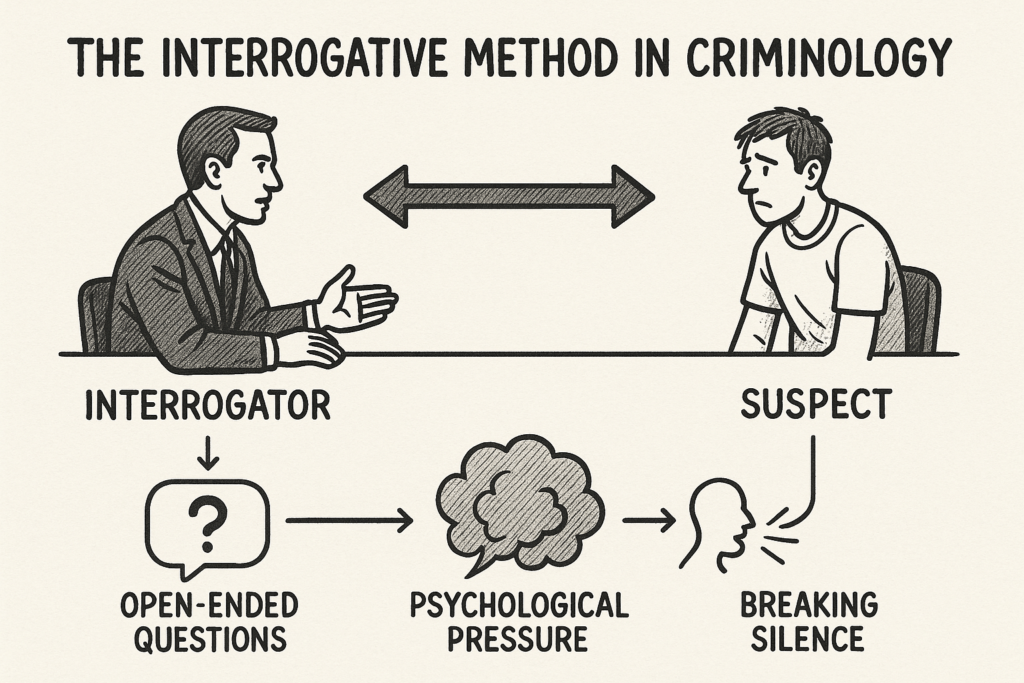Introduction
Criminology is the scientific study of crime, criminal behavior, and the criminal justice system. It aims to analyze the causes, nature, and consequences of criminal acts in society. Within this field, researchers use various tools to uncover patterns, test theories, and interpret criminal phenomena. Two core methodologies dominate criminological research: the statistical method and the interrogative method. These methods provide both quantitative and qualitative insights, allowing scholars to measure crime trends and also explore the deeper psychological and sociological factors driving deviant behavior.
In this article, we will explore these two research methods in depth, examining their theoretical foundations, practical applications, advantages, and limitations. We will also highlight the contributions of prominent criminologists such as Cesare Lombroso, Enrico Ferri, and Raffaele Garofalo, whose work laid the foundation for modern criminological thought.
Understanding Criminology and Its Scientific Foundations
Definition and Scope of Criminology
Criminology is more than just the study of crime; it is a dynamic and evolving science that draws on disciplines such as sociology, psychology, biology, law, and statistics. It seeks to answer fundamental questions: Why do people commit crimes? How can crime be prevented? What are the most effective strategies for rehabilitation and punishment?
Criminologists analyze a wide range of data, from crime statistics and offender profiles to societal structures and psychological assessments. The field encompasses multiple schools of thought—ranging from the classical school, which emphasizes free will and rational choice, to the positivist school, which considers biological and environmental determinism.
Historical Development and Key Thinkers
The evolution of criminology as a scientific field began in the 19th century with pioneers like Cesare Lombroso, often called the “father of modern criminology.” Lombroso believed in a biological basis for criminal behavior and used statistical data to support his theory of the “born criminal.”
Enrico Ferri, a student of Lombroso, expanded the scope to include social and economic causes, while Raffaele Garofalo emphasized the concept of “natural crime” rooted in moral anomalies. These thinkers introduced empirical and systematic approaches to crime study, paving the way for the integration of the statistical and interrogative methods in contemporary research.
The Role of Research Methods in Criminology
Importance of Scientific Methodology
Scientific research methods are essential for generating reliable and valid knowledge in criminology. Without them, conclusions about crime trends, offender behavior, or policy effectiveness would be speculative. Research methods serve as the backbone of theory testing and policy formulation.
Quantitative methods, such as statistical analysis, allow researchers to identify broad patterns and trends. Qualitative methods, like interviews and case studies, provide depth and context. Together, they create a comprehensive understanding of criminal behavior and justice system responses.
The Statistical Method in the Study of Crime
Definition and Features
The statistical method involves collecting and analyzing numerical data to identify patterns, correlations, and trends in criminal activity. It is widely used in criminological research to test hypotheses, evaluate policies, and compare crime rates across regions and populations.
This method relies on data sources such as police reports, court records, victimization surveys, and census data. It transforms complex social phenomena into measurable variables that can be systematically studied.
Application in Criminological Research
The statistical method is used to:
- Determine crime prevalence and distribution
- Evaluate the impact of socioeconomic factors on crime rates
- Assess the effectiveness of intervention programs
- Identify high-crime areas through geospatial mapping
For instance, researchers might analyze national crime databases to detect a rise in juvenile delinquency in urban centers, correlating it with school dropout rates or unemployment levels.
Tools and Techniques
Statistical techniques commonly used in criminology include:
- Descriptive statistics: Used to summarize basic features of data, such as mean, median, and frequency.
- Inferential statistics: Applied to draw conclusions from sample data, including regression analysis, chi-square tests, and ANOVA.
- Crime mapping and predictive analytics: Use geographic information systems (GIS) and machine learning to predict future criminal activity based on existing data patterns.
Advantages and Limitations
Advantages:
- Offers objective, quantifiable evidence
- Enables analysis of large populations
- Facilitates comparison across time and space
Limitations:
- May miss unreported crimes (the “dark figure” of crime)
- Lacks contextual depth and personal perspectives
- Data quality depends on reporting accuracy and consistency
The Statistical Method in the Study of Crime: Additional Clarification and Insights
Analytical Summary and Added Perspectives
The strength of the statistical method lies in its ability to transform social behaviors into measurable indicators, allowing researchers to develop predictive models and evidence-based explanations. By using this method, criminologists can create numerical maps of crime patterns that reveal seasonal trends (e.g., increased thefts during holidays) or vulnerable groups (e.g., elderly victims of fraud).
Added Insight: A growing application of this method involves integrating artificial intelligence (AI) and machine learning algorithms with crime data. These technologies enable the rapid processing of massive datasets, revealing recurring patterns and forecasting potential threats with impressive precision—something traditional statistics may struggle to achieve on its own.
Clarifying Note: The reliability of statistical findings depends heavily on the accuracy and completeness of data sources. Therefore, successful implementation of this method requires close collaboration between law enforcement agencies, public institutions, and academic researchers to ensure data integrity and consistency.
Complementarity with Other Methods
While the statistical method excels at answering “how often” and “where” crimes occur, it often falls short of explaining “why” they happen. This limitation highlights the importance of combining it with qualitative approaches, such as the interrogative method, to capture the human stories and psychological motivations behind the numbers.

The Interrogative Method in Criminology
Definition and Nature
The interrogative method (also known as the interview or qualitative method) involves directly engaging with individuals to understand their experiences, beliefs, and motivations related to crime. It is commonly used in ethnographic research, case studies, and psychological profiling.
This method is essential for exploring complex issues that cannot be reduced to numbers, such as the emotional impact of victimization or the social dynamics of gang membership.
Usage in Criminological Studies
Criminologists use the interrogative method to:
- Investigate offender motivations and decision-making processes
- Understand the lived experiences of victims
- Explore cultural and structural influences on criminal behavior
- Develop theories based on firsthand accounts
For example, an in-depth interview with a repeat offender might reveal early-life trauma or systemic neglect that contributed to criminal pathways—insights not easily captured through statistical data.
Techniques and Ethical Considerations
Key techniques include:
- Structured interviews: Pre-determined questions, ensuring consistency
- Semi-structured interviews: A mix of planned and open-ended questions
- Unstructured interviews: Free-flowing conversations guided by the participant
Ethical principles include:
- Informed consent
- Confidentiality and anonymity
- Minimization of harm
Strengths and Drawbacks
Strengths:
- Provides rich, detailed data
- Captures human emotions, motivations, and contexts
- Suitable for developing new theories and exploring new areas
Drawbacks:
- Subject to bias (both researcher and participant)
- Limited generalizability due to small sample sizes
- Time-consuming and resource-intensive
The Interrogative Method in Criminology: Additional Clarification and Insights
Deeper Emphasis on Methodological Importance
The interrogative method goes beyond surface-level observations by entering the subjective world of individuals involved in crime—whether offenders, victims, or witnesses. It is particularly valuable in contexts where emotional, social, or cultural variables shape behavior in ways that numbers cannot capture.
Added Clarification: This method is vital when studying sensitive or hidden aspects of criminal life, such as coercion into gangs, experiences of abuse, or distrust in law enforcement. It enables the researcher to uncover layers of meaning, contradiction, and trauma that are often silenced in official reports.
Insightful Expansion: When conducted skillfully, interviews can also serve as a therapeutic or empowering experience for participants, especially victims, by giving them a voice in the research process. However, this power must be managed with ethical sensitivity and methodological rigor to avoid re-traumatization or bias.
Integration with Quantitative Approaches
Though qualitative by nature, the interrogative method can complement statistical analysis by generating hypotheses, providing explanatory depth, and validating patterns observed in quantitative data. For example, if statistics show a spike in youth violence, interviews with affected communities can help reveal the underlying causes—such as school exclusion, neighborhood violence, or lack of employment.

Integrating Both Methods: A Mixed-Methods Approach
Complementary Strengths
Using both statistical and interrogative methods allows researchers to validate quantitative findings with qualitative insights. This mixed-methods approach is increasingly popular in modern criminology as it bridges the gap between empirical measurement and human experience.
Examples of Mixed-Method Research in Criminology
- A study on domestic violence might use national statistics to show rising trends while also interviewing victims to understand the psychological toll and barriers to reporting.
- Crime prevention programs can be evaluated using crime rate data and participant interviews to assess personal impact.
Criminological Theories and Methodological Implications
Classical and Positivist Theories
The classical school, associated with theorists like Beccaria and Bentham, emphasized rationality and deterrence, relying on statistical analysis to support the effectiveness of laws and punishments.
The positivist school, championed by Lombroso and Ferri, used empirical observation and biological measurements, combining statistical and interrogative techniques to identify criminal typologies.
Sociological and Psychological Theories
Sociological theories such as strain theory, social learning theory, and labeling theory benefit from both methods. For example:
- Strain theory might be tested using crime data (statistical) and interviews with marginalized youth (interrogative).
- Labeling theory relies heavily on qualitative accounts of how individuals internalize societal labels.
Psychological theories often depend on in-depth case studies, which are rooted in interrogative methods but may also incorporate statistical trends (e.g., prevalence of mental health disorders among offenders).
Contributions of Key Criminologists to Methodology
Cesare Lombroso
Lombroso‘s work exemplifies the early use of scientific methods in criminology. He collected data on skull shapes, physical anomalies, and behavior to classify “criminal types.” His reliance on measurement and observation laid the groundwork for both statistical and interrogative techniques.
Enrico Ferri
Ferri expanded the focus beyond biology to include social and environmental influences. He promoted the use of demographic data, aligning closely with statistical approaches while also valuing direct observation and interviews.
Contemporary Scholars
Modern criminologists such as Travis Hirschi, Robert Agnew, and Howard Becker have used both methods to develop and test theories like social bond theory, general strain theory, and labeling theory, demonstrating the enduring relevance of methodological diversity.
Future Directions in Criminological Research
Technological Integration
Advancements in technology are reshaping criminological methods. Tools like predictive analytics, AI-driven policing, and digital ethnography combine statistical modeling with real-time observation, enhancing both accuracy and responsiveness.
Evolving Ethical Standards
As research becomes more invasive or data-driven, ethical considerations are gaining prominence. Researchers must balance the pursuit of knowledge with respect for privacy, consent, and the potential impact on vulnerable populations.
Conclusion
The statistical and interrogative methods are foundational to the study of crime. Each offers unique strengths—objectivity and scalability in statistics; depth and human connection in interviews. Together, they equip criminologists with the tools to understand crime in all its complexity, from trends and correlations to motives and experiences. As criminology evolves, integrating these methods will be crucial for developing holistic and effective approaches to crime prevention, rehabilitation, and policy-making.

References
- Wikipedia Contributors. (2022). Quantitative Methods in Criminology. Wikipedia.
Link to the article on Wikipedia - iResearchNet Contributors. (2022). Criminology Research Methods. iResearchNet.
Link to the article on iResearchNet - Fiveable Contributors. (2021). Research Methods in Criminology. Fiveable.
Link to the study guide on Fiveable - American Public University Contributors. (2020). The Importance of Research Methods in Criminal Justice. American Public University.
Link to the article on American Public University

